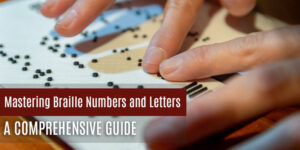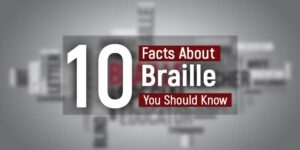In a world where communication largely relies on visual and auditory means, it’s important to remember that not everyone experiences the world in the same way.
Braille services provide millions of visually impaired individuals a lifeline, an effective form of reading and writing that allows them to access information freely while expressing themselves without restrictions or limits.
In this blog, we’ll take a journey into the world of Braille transcription services, exploring what it is, how it works, and its significance in the lives of those who use it.

What Is Braille?
Braille, a tactile writing and reading system consisting of raised dots representing letters, numbers, musical notes and even other musical symbols.
Developed by Louis Braille in the early 19th century, Braille has revolutionized life for blind and visually impaired individuals by giving them access to reading and writing independently.
The Braille Alphabet
The foundation of Braille is its alphabet, which consists of raised dots arranged in specific patterns to represent each letter. Braille uses six-dot cells with two vertical columns of three dots each, where any combination of raised dots can represent every letter from its alphabet, plus various contractions and short-form words.
Punctuation marks are also assigned specific combinations of dots within the cell. For example, a period is represented by dots 245 in the cell, while a comma is represented by dot 2 alone.
Numbers and Punctuation
Braille transcription not only includes letters from the alphabet but also numbers and punctuation symbols. Numbers are represented using six-dot cells but with an indicator to denote it is numeral rather than alphabetic text.
Reading Braille
Reading Braille requires both touch sensitivity and practice to master. Users use their fingertips to trace across each Braille character, feeling its raised dots with their fingertips, and quickly identify each one by touch alone with practice. Braille books and documents printed with raised dots make them easily accessible for blind readers.
Interestingly, there are different Braille codes used in different countries. For instance, there’s the U.S. Braille code, which is used in the United States and several other countries, and there are variations for different languages for French Braille, German Braille and more – though their basic principles remain the same, and their specific symbols and conventions may differ between codes.
Writing Braille
Braille writing involves creating raised dots on paper or other surfaces using various writing instruments such as slates and styluses that emboss dots onto paper surfaces, typewriters, and electronic Braille devices that make Braille writing more efficient.
Writing Braille requires having an in-depth knowledge of its alphabet and the proper placement of dots within a six-dot cell. While practice will make perfect, eventually, users become proficient writers as they read Braille.
Braille’s Significance
Braille is more than just symbols; it provides access and tor blind and visually impaired individuals. Here are several reasons why Braille services hold immense value:
- Literacy and Education
Learning Braille is essential for the education of blind children, providing access to textbooks, literature and educational material and opening a world of knowledge to them.
- Communication
Braille allows blind individuals to communicate independently through written language. They can write letters, notes and messages just like anyone else.
- Employment
Braille proficiency can be an essential asset when it comes to finding work. Many jobs require reading and writing, making Braille’s expertise invaluable in today’s job market.
- Access to Information
Braille transcription provides access to printed materials ranging from books and newspapers signs and labels – essential tools for everyday tasks as well as staying informed of world affairs.
- Inclusion and Equality
Braille Promotes Inclusion and Equality Braille provides visually impaired individuals with equal opportunities and ensures they can participate fully in society while eliminating barriers and fully participate in society.
Challenges and Advancements
Braille is an impressive system, yet it comes with some inherent drawbacks. Materials for making Braille documents may be scarce, and production time may take an excessively long amount of time.
Digital technology presents both opportunities and challenges. While screen readers and voice-activated technology have increased access, they also raise concern over Braille being replaced by more accessible technologies like voice-activated technology.
Conclusion
Braille transcriptions are more than just a writing system – they stand as a symbol of independence, inclusiveness, and equal opportunity for blind and visually impaired individuals. By helping them read, write, communicate, and access information more freely, it improves education, employment and overall quality of life. Braille faces challenges in today’s digital era, yet it also benefits from technological innovations that make it more accessible and relevant. As we work toward an inclusive society, Braille Services stands as a beacon of hope and progress, reminding us all that everyone should have equal participation opportunities in life.






